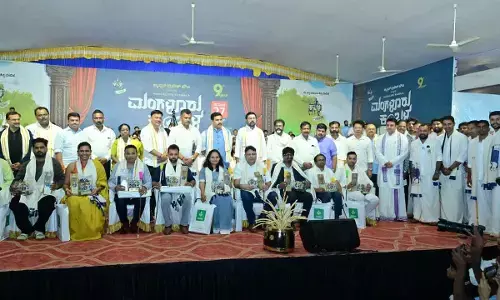A myopic view of Indian democracy

A systematic campaign is on in foreign media to paint that India is not a truly democratic country and that the indices that measure the human rights or democracy show the precipitous decline of democracy, particularly during the nine-year rule of Modi
A systematic campaign is on in foreign media to paint that India is not a truly democratic country and that the indices that measure the human rights or democracy show the precipitous decline of democracy, particularly during the nine-year rule of Modi. Though it is a fact that certain aberrations had taken place and tendencies of autocracy were displayed by some ruling parties in different states during the last two decades, it would be wrong to say that India is not democratic.
The fact is no one can destroy India’s democracy. India is the only country which holds elections regularly. If one takes into consideration the growth indices into account in the last nine years, India has become the world’s fifth largest economy. This was endorsed even by the World Economic Forum (WEF).
According to WEF, India overtook UK last year. Some international economists and some political parties including the Indian National Congress have been sceptical over the claims made by the WEF and the Government of India, though they are still unable to prove the statistics wrong. On the other hand, the Chief Economic Adviser to Government of India in March said that the economy grew 7.2% last year.
Every state government claims they have become a role model for the country and that their economies are zooming ahead in terms of growth. The country’s economic growth depends on the growth of the states. However, they do not want to accept that India is growing but wants everyone to clap when they say their state is ahead of others.
Well, the debate on the economic growth will continue till Lok Sabha elections due next year are over. The very fact that every state government is able to articulate its view and also lash out at the Union government is a major indicator of the level of democracy that India enjoys. It is also undisputable that India is among top 10 destinations for foreign direct investment in the world. India is one country where there has been a stable government and is on the path of prosperity. India is a recognised military power and is part of Quad, (‘Quadrilateral Security Dialogue’), which is an informal strategic forum comprising four nations, namely, United States of America (USA), India, Australia and Japan. One of the primary objectives of the Quad is to work for a free, open, prosperous and inclusive Indo-Pacific region.
The very fact that a section of western media does not get tired of taking up a systematic criticism of India and jump at conclusions and come up with all kinds of opinions with quotes from some Indian writers and intellectuals indicates that there is no dip in democracy in India.
India’s democracy will continue to be as strong as ever because its foundation is based on certain institutions. One is executive which is elected through regular elections for the Lok Sabha and state legislatures which decide who would be the Prime Minister of the country or the Chief Minister of a state.
There is judiciary which takes care of any issues and wrong decisions taken by the political executive. The third one is the media. Freedom of religion and freedom of expression are again the highest in India, which goes to prove that the democracy is very vibrant here. All that is required is the analysts should not view things with a myopic view. Yet, the western media says India’s democracy was never of very high-quality. This is a highly biased perception. Some of them quote how the Congress regime under Indira Gandhi had imposed emergency and charge the present NDA government as being autocratic. Well, we shall discuss the autocratic tendencies separately.
The western media and some of the political parties in India who believe more in what foreign media says should ponder over what White House had said about democracy in India. It said India has a vibrant democracy and anybody who happens to go to New Delhi can see that for themselves. This statement was made on June 5, 2023 dismissing concerns about the health of democracy in India.
One thing which no one can deny is that in the last one and a half decades or so, some tendencies of autocratic style of functioning among the ruling parties both at the central level and the states were seen. The regional parties, which have somehow started thinking that they are supreme and want to remain in power for long periods, have been resorting to making certain laws which create problems in the discharge of duties of the opposition parties. But thanks to the strong judiciary, many of such decisions by the political executive were struck down and the courts put some checks on the autocratic behaviour of the governments. In some states like Andhra Pradesh, Telangana, West Bengal, Delhi, such tendencies are seen more.
In many states including the aforementioned states, the regional parties in power have become intolerant to opposition and media and their criticism of the government. Another trend is a majority of the political parties have come up with their own media houses. There would have been nothing wrong if they had used their media houses for propaganda of what their party and government do. But the focus has been more on maligning the opposition parties. Add to it the growing popularity of social media and the way the social media wings of political parties which try to twist the facts, thus badly denting the credibility of the news.
These parties when in opposition had shouted from roof tops that the government of the day was denying civil liberties and created never-see-before situations where the freedom of expression was sought to be curtailed. They imposed unreasonable restrictions and made it mandatory to obtain police permission for all kinds of protests and road shows. While no rules apply to the ruling party, the opposition never gets permission. This kind of situation resulted in increased role of judicial intervention.
The media in India which was a mirror to the omissions and commissions of the government – central or state – has been tamed to some extent through various methods affecting independent journalism to some extent. Many publications have started imposing self-censorship to avoid legal complications including cases of sedition.
All ruling parties claim that they have a policy of zero tolerance towards corruption. But they tend to be fully tolerant towards corruption within the party or family. Every leader claims to be an apostle of highest moral values but they advise the voters to take money from opponents and vote for them. This is the new definition of loyalty they teach to the people. They say that introduction of technology in governance had helped in curbing corruption, but it is still unabated because to get their job done one has to grease the palms of officials. This is the ground reality though no leader or official will accept it.
The lust for power has resulted in making the polls very expensive. It is a known fact that unless one has money and muscle power, he is not fit to contest the polls. In the past, the winning chances of a candidate used to depend on his track record of working for the people in the constituency. Now leaders and parties remember the common man just before the elections, show crispy notes and liquor bottles and go in for advance booking of votes.
The opposition parties are also no holy cows. Accusing the ruling party of adopting all kinds of wrong methods to win elections, they enter into alliances but refuse to put up one single candidate against the ruling party candidate.
Let’s take the example of Delhi where AAP is part of I.N.D.I.A, a conglomeration of 26 parties. The Congress which is supposed to the leading party claims it will contest all seats in Delhi on its own. The CPM decides not to have any alliance with Trinamul Congress in West Bengal. But all of them vow they will unitedly pull down the BJP led NDA government. Every party says they are willing to cooperate if the other modifies.
Well, the western media should take a deeper look at all these diversities in India and open their eyes that all this is possible here only because democracy is vibrant and shall remain so. Such unity in diversity is not and cannot be there in any other country.
















